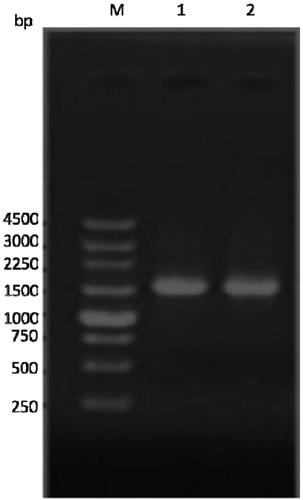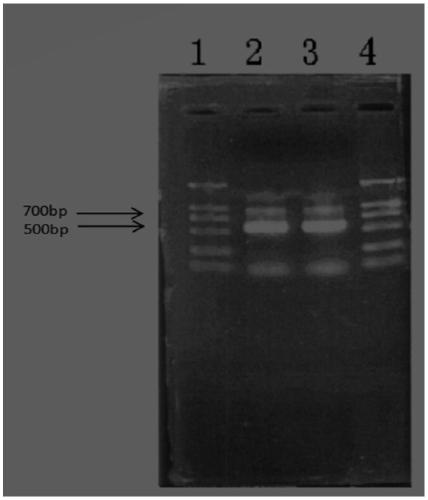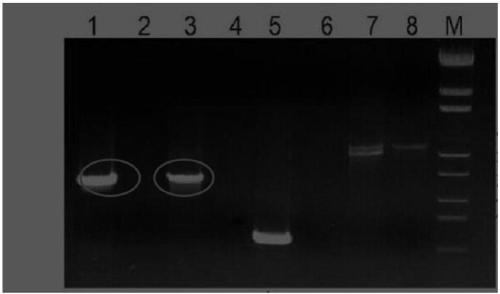Composite microbial symbiosis induction culture technology based on SOD (Superoxide Dismutase), microbial symbiosis culture agent and application of composite microbial symbiosis induction culture method and microbial symbiosis culture agent
A symbiotic culture and microorganism technology, applied in microorganism-based methods, microorganisms, methods of using microorganisms, etc., can solve the problems of large amount of strain, long process flow, poor environmental adaptability, etc., and achieves low preparation cost and wide application range. , the effect of strong adaptation
- Summary
- Abstract
- Description
- Claims
- Application Information
AI Technical Summary
Problems solved by technology
Method used
Image
Examples
Embodiment 1
[0097] Aerobic bacteria: Bacillus subtilis;
[0098] Anaerobic bacteria: Methanogens;
[0099] 1. Collect strains and enrich culture in the culture medium: aerobic bacteria use the first culture medium, 37 ° C, conventional culture in a biochemical incubator; anaerobic bacteria use the second culture medium and enter the mixed gas in the anaerobic workstation: 10% h 2 , 10% CO 2 , 80%N 2 . Culture for 2-3 days.
[0100] 2. Take the bacterial solution described in 1 and add sterile water to dilute to 10 4 cfu / ml, 10 6 cfu / ml, 10 8 cfu / ml. Take 0.1-0.2mL of each dilution to smear on a plate, and culture in 3 parallels for 2-3 days at 37°C. Pick different single colonies according to the morphological characteristics of the colony, and streak for purification.
[0101] 3. Pick the purified colony and culture it upside down for 3-4 days, scrape the bacteria, and do molecular biology and morphological identification.
[0102] 4. Add 0.005-0.05% SOD (20000IU / g) to the anae...
Embodiment 2
[0113] Facultative anaerobes: Bacillus amyloliquefaciens, Bacillus Velez, Bacillus cereus and Bacillus pumilus;
[0114] Anaerobic bacteria: denitrifying bacteria;
[0115]1. Collect strains, enrich culture in the medium: the first medium for facultative anaerobic bacteria, place it in a three-gas incubator, and pass in a mixed gas: 5% O 2 , 10% CO 2 , 80%N 2 ; Anaerobic bacteria pass into mixed gas in the anaerobic workstation with the second culture medium: 10%H 2 , 10% CO 2 , 80%N 2 . Incubate for 2-3 days.
[0116] 2. Take the bacterial solution described in 1 and add sterile water to dilute to 10 4 cfu / ml, 10 6 cfu / ml, 10 8 cfu / ml. Take 0.1-0.2mL of each dilution to smear on a plate, and culture in 3 parallels for 2-3 days at 37°C. Pick different single colonies according to the morphological characteristics of the colony, and streak for purification.
[0117] 3. Pick the purified colony and culture it upside down for 3-4 days, scrape the bacteria, and do molec...
Embodiment 3
[0132] Aerobic bacteria: Acetobacter;
[0133] Facultative anaerobes: Bacillus licheniformis;
[0134] Anaerobic bacteria: denitrifying bacteria;
[0135] 1. Collect strains and enrich culture in the culture medium: the first culture medium for aerobic bacteria, 37 ° C, conventional culture in a biochemical incubator; the first medium for facultative anaerobic bacteria, placed in a three-gas incubator, Inject mixed gas: 5% O 2 , 10% CO 2 , 80%N 2 ; Anaerobic bacteria pass into mixed gas in the anaerobic workstation with the second culture medium: 10%H 2 , 10% CO 2 , 80%N 2 . Culture for 2-3 days.
[0136] 2. Take the bacterial solution described in 1 and add sterile water to dilute to 10 4 cfu / ml, 10 6 cfu / ml, 10 8 cfu / ml. For each dilution, take 0.1-0.2mL to smear on a plate, and culture in 3 parallels for 2-3 days at 37°C. Pick different single colonies according to the morphological characteristics of the colony, and streak for purification.
[0137] 3. Pick th...
PUM
 Login to View More
Login to View More Abstract
Description
Claims
Application Information
 Login to View More
Login to View More - R&D
- Intellectual Property
- Life Sciences
- Materials
- Tech Scout
- Unparalleled Data Quality
- Higher Quality Content
- 60% Fewer Hallucinations
Browse by: Latest US Patents, China's latest patents, Technical Efficacy Thesaurus, Application Domain, Technology Topic, Popular Technical Reports.
© 2025 PatSnap. All rights reserved.Legal|Privacy policy|Modern Slavery Act Transparency Statement|Sitemap|About US| Contact US: help@patsnap.com



